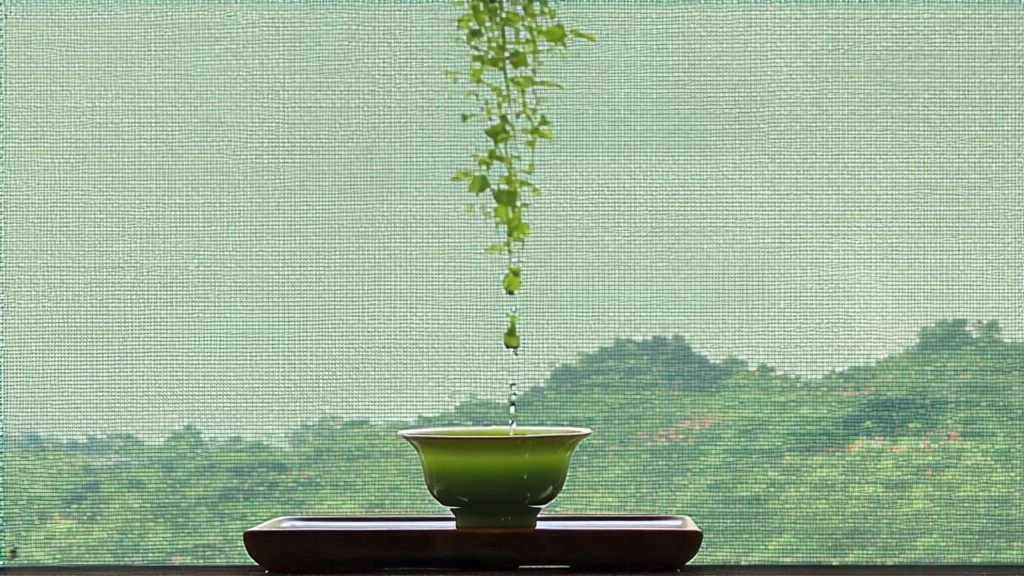
Few leaves carry as much legend, craftsmanship, and sensory drama as Tie Guan Yin, the “Iron Goddess of Mercy.” Originating in the granite-studded hills of Anxi in southern Fujian, this celebrated oolong has, for almost three centuries, seduced poets, merchants, and emperors with its orchid fragrance, lingering sweetness, and the uncanny ability to rebrew itself a dozen times without boredom. To understand China’s vast oolong family, one must begin here, where myth and chemistry share the same clay kettle.
Legend whispers that in the 1720s a poor farmer named Wei Yin faithfully cleaned a neglected shrine to Guan Yin, the Bodhisattva of Compassion. One night the goddess appeared in a dream, directing him to a hidden cave behind the temple. There he found a single tea shoot shimmering in moonlight. Planting it in his field, he nurtured the bush, crafted the leaves with meticulous hand-rubs, and discovered a liquor so fragrant it seemed liquid incense. Villagers, tasting the tea, felt both bodily restoration and quiet joy; they named it after the iron statue of the goddess herself—Tie Guan Yin—honoring the durable leaf and the compassionate spirit.
History records a more earthly but equally fascinating trajectory. By the late Qing dynasty, Anxi farmers had perfected a partial-oxidation technique that sat halfway between green and black tea, creating an entirely new category that Cantonese merchants labeled “oolong,” or “black dragon,” for the serpentine shape of the finished leaf. Tie Guan Yin quickly dominated the Minnan tea market, traveling on clipper ships to Southeast Asia where Hokkien migrants recreated hometown altars with every kettle. In 1915, it won gold at the Panama-Pacific International Exposition, sealing its global reputation. Today, protected-origin status restricts the name “Anxi Tie Guan Yin” to 24 designated townships; within those boundaries, microclimates, elevation, and soil chemistry generate a kaleidoscope of styles that connoisseurs parse with Burgundian obsession.
Modern classification divides Tie Guan Yin into four main stylistic families. Traditional or “strong style” (nong xiang) endures 50–60 % oxidation and medium roasting over charcoal embers, yielding amber liquor, roasted nut and dried-fruit notes, and a warming finish beloved by elderly drinkers and Chaozhou gongfu masters. The “light style” (qing xiang) that rose to fame in the 1990s stops oxidation at 15–25 %, skips roasting, and celebrates a jade-green leaf with explosive florals—think white orchid, lily, and a hint of fresh cream—set against a bright, almost effervescent body. Between these poles lie “moderate style” (zhong xiang) and the rare “aged style” (chen xiang), where lightly baked leaves rest in earthen jars for decades, developing dark-fruit, sandalwood, and medicinal depth reminiscent of old pu-erh. Each style demands its own dialect of soil, cultivar, and weather; even within a single mountainside, morning fog or a late monsoon can tilt the cup from gardenia to green almond.
Crafting Tie Guan Yin is a 24-hour choreography of timing, muscle memory, and weather divination. Picking begins at dawn when two leaves and a bud still hold mountain dew; experienced pluckers read the purple tinge on leaf edges as a signal of optimal polyphenol content. The harvest is rushed to the village alley where withering racks of woven bamboo await. Sun-withering lasts only twenty minutes—just long enough for the leaves to lose their brittleness—before they are moved indoors for “cooling green,” a resting phase that coaxes grassy volatiles toward floral precursors. Next comes the signature “shaking green”: 200 grams of leaves are tossed inside a cylindrical bamboo drum rotating at 30 rpm, bruising edges against ribs to trigger oxidation while keeping the leaf center green. Masters listen for a subtle rustle likened to “spring rain on young loquat,” an auditory cue that oxidation has reached the desired 20 %. After two hours of repeated shaking and resting, leaves emit a heady perfume of ripe mango and narcissus; at this moment the enzyme polyphenol oxidase has etched a red fringe around each leaf without invading the core.
Fixation follows: leaves are plunged into a 270 °C drum roaster for ninety